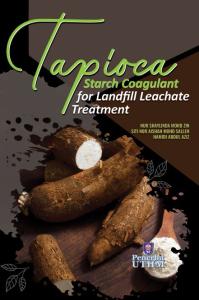Tapioca Starch Coagulant for LandfillLeachate Treatment
Keywords:
landfill management,natural coagulants, starch tapioca flour and tapioca peelSynopsis
Coagulation-flocculation is applied for various wastewater such as sewage, industrial, and leachate, which has the proven ability to remove pollutants through a solid-liquid separation process. Coagulant is a material added during coagulation with chemical coagulants used conventionally. However, using natural coagulants to replace chemical coagulants is widely studied. This book highlights the application of natural tapioca starch coagulant for the coagulation-flocculation of stabilised leachate. This book’s content is also regarded as an alternative solution for leachate treatment for landfill management. This book first presented information on landfills and leachate, followed by starch as a natural coagulant from a previous study. It compiles the research study and highlights the application of natural coagulants made from starch tapioca flour and tapioca peel in the form of single, dual and composite coagulants. Finally, it helps academics, researchers, and students better understand the application of natural starch-root coagulant for treating landfill leachate.
Downloads
References
Azizan, M. O. (2019). Leachate treatment by using composite coagulant made from polyaluminium chloride (PAC) and
tapioca starch (TS). Master Thesis. Universiti Tun Hussien Onn Malaysia.
Banch, T. J., Hanafiah, M. M., Alkarkhi, A. F., & Abu Amr, S. S. (2019). Factorial design and optimization of landfill leachate
treatment using tannin-based natural coagulant. Polymers, 11(8), 1349.
Cortez, S., Teixeira, P., Oliveira, R.., & Mota, M. (2011). Evaluation of Fenton and ozone-based advanced oxidation processes as mature landfill leachate pre-treatments. Journal of Environmental Management, 92, 749-755.
Daud Z., Detho A., Rosli, M. A., Awang, H., Ridzuan, M. B. & Tajarudin, H. A. (2022). Optimization of mixing ratio, shaking speed, contact time, and pH on reduction of Chemical Oxygen Demand (COD) and Ammoniacal Nitrogen (NH3-N) in leachate treatment. Journal of the Air & Waste Management Association, 72(1), 24-33.
Environmental Quality Act 1974 and Regulations (1997). MDC Sdn. Bhd. Malaysia
Faiz, M. A. Z. M., Yusoff, M. S., & Aziz, H. A. (2014). The Study of Flocculant Characteristics for Landfill Leachate Treatment Using Starch Based Flocculant from Durio Zibethinus Seed, Advances in Environmental Biology, 8(15), 129– 135.
Ghosh, S., & Hasan, S. E. (2010). Sanitary Landfill. Engineering Geology, Environmental Geology &, III. Retrieved from
https://www.eolss.net/SampleChapters/C09/E6-65-02-05.pdf
Huang, C., & Chen, Y. (1996) Coagulation of colloidal particles in water by chitosan. Journal of Chemical Technology and Biotechnology 1996, 66(3), 227-232.
Ismail, S. N. S., & Manaf, L. A. (2013). The challenge of future landfill: A case study of Malaysia. Journal of Toxicology
and Environmental Health Sciences, 5(6), 86–96. http://doi.org/10.5897/JTEHS12.058
Jaganathan J. S., Sheikh Abdullah, S. R., Ismail, N I., Siti Shilatul Najwa Sharuddin, S. S. N. (2022). Coagulation-
Flocculation Process of Nutrient-Rich Suspended Solids from Aquaculture Effluent Using Bioflocculant. Journal of
Biochemistry, Microbiology, and Biotechnology, Vol 10, No SP2, 46-56, https://doi.org/10.54987/jobimb.v10iSP2.728
Kurniawan, T. A., Lo, W. H, & Chan, G. (2006). Physico-chemical treatments for removal of recalcitrant contaminants from landfill leachate. Journal of Hazardous Materials 2006, 129(1), 80-100.
Lee, K. E., Morad, N., Teng, T. T., & Poh, B. T. (2012). Development, characterization and the application of hybrid materials in coagulation/flocculation of wastewater: A review. Chemical Engineering Journal, 203, 370–386. http://doi.org/ 10.1016/j.cej.2012.06.109
MyMetro (2016) Sasar 22% Kadar Kitar Semula. https://www. hmetro.com.my/node/141942 Retrieved on 20 January
Naveen, B. P., Puvvadi, S., & Sitharam, T. G. (2014). Characteristics of a Municipal Solid Waste Landfill. Proceedings of Indian Geotechnical Conference IGC-2014, (December 18-20), 1–7. http://doi.org/10.13140/2.1.4972.4489
Ong, S. L. (2010). A study of landfill leachate treatment by PACl, Sago starch and Tapioca starches, Hymenocallis Liriosme and Aloe Vera as coagulant. Master Thesis. Universiti Sains Malaysia.
Prihatinningtyas, E., & Effendi, A. J. (2022, July). Performance of natural coagulant extracted from tapioca and corn flour for the treatment of tofu wastewater. In IOP Conference Series: Earth and Environmental Science (Vol. 1062, No. 1, p. 012030). IOP Publishing.
Qudsieh, I. Y., Fakhru’-Razi, A., Kabbashi, N. A., Mirghani, M. E. S., Fandi, K. G., Alam, M. Z., Muyibi, S. A., & Nasef, M. M. (2008). Preparation and Characterization of a New Coagulant Based on the Sago Starch Biopolymer and Its Application in Water Turbidity Removal. Journal of Applied Polymer Science, 109, 3140–3147. http://doi.org/10.1002/app
Radhi, N. A. M. (2020). Expert: Do more for garbage management, Retrieved on March 18, 2020, on https://www. nst.com.my/news/nation/2020/02/568254/expert-do-more-garbage-management
Syafalni, Lim, H. K., Ismail, N., Abustan, I., Murshed, M. F., & Ahmad, A. (2012). Treatment of landfill leachate by using lateritic soil as a natural coagulant. Journal of Environmental Management, 112, 353–359. http://doi.org/10.1016/j.jenvman.2012.08.001
Taib, M. R., Mook, B. N., Tahir, M. I. H. M., Aziz, M. A. A. (2021). Electrocoagulation Treatment of Sanitary Landfill Leachate in Malaysia. IOP Conf. Series: Materials Science and Engineering 1051 (012074) IOP Publishing, doi:10.1088/1757-899X/1051/1/012074
Umar, M., Aziz, H. A., & Yusoff, M. S. (2010). Variability of parameters involved in leachate pollution index and determination of LPI from four landfills in Malaysia. International Journal of Chemical Engineering, 1-6.
Verma, M., & Kumar, N. R. (2016). Can coagulation–flocculation be an effective pre-treatment option for landfill leachate and municipal wastewater co-treatment? Perspectives in Science, 8, 492–494. http://doi.org/10.1016/j.pisc.2016.05.005
Xu, M., Wu, C., Li, Y., Zhou, Y., Xue, H., & Yu, Y. (2018). Coagulation Behavior and Floc Properties of Dosing Different Alkaline Neutralizers into the Fenton Oxidation Effluent. Water, Air, & Soil Pollution, 229(382), 1–12.
Yalcuk, A. & Ugurlu, A, (2009). Comparison of horizontal and vertical constructed wetland systems for landfill leachate
treatment. Bioresource Technology, 100(9), 2521-2526.
Yusoff, M. S., & Mohamad-Zuki, N. A. (2015). Optimum of Treatment Condition for Artocarpus heterophyllus Seeds Starch as Natural Coagulant Aid in Landfill Leachate Treatment by RSM. Applied Mechanics and Materials, 802, 484–489. http://doi.org/10.4028/www.scientific.net/AMM.802.484
Zainol, N. A., Aziz, H. A., Yusoff, M. S., & Umar, M. (2011). The use of Polyaluminum Chloride for the treatment of Landfill Leachate via Coagulation and Flocculation processes. Research Journal of Chemical Sciences, 1(3), 34–39.




